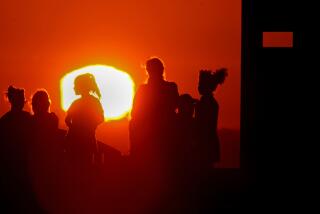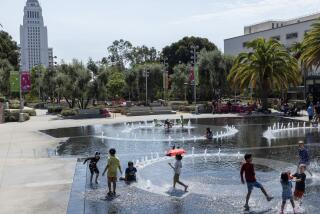Well, it was a mild summer -- until now
- Share via
Hope you enjoyed that mild summer while it lasted.
An extended heat wave that could bring record temperatures is moving into Southern California this week, and fire officials are worried about wildfires.
Before the heat peaks Wednesday, temperatures in the Santa Clarita Valley and West San Fernando Valley could reach 107 degrees, as well as 90 degrees in downtown Los Angeles, according to the National Weather Service.
Nighttime temperatures are expected to be high while humidity hovers in the single-digit range as a seasonal high-pressure system centered over Arizona strengthens and shifts toward Southern California, blocking sea breezes.
Weather service advisories recommend that residents stay indoors from at least late morning through early evening until the heat passes. Temperatures could “quickly rise to life-threatening levels” for children, pets and the elderly in closed vehicles.
The weather service issued a red flag fire warning until 8 a.m. Wednesday for the mountains of Los Angeles County, where “hot temperatures, gusty winds and very low humidities” are creating a tinderbox environment, according to an advisory Monday.
Santa Clarita, Malibu and the Los Angeles foothills are all high-hazard areas, and the potential for wind-driven, fast-moving fires is great, said Inspector Ron Haralson of the Los Angeles County Fire Department.
“It’ll be the warmest in the mountains and valleys,” said National Weather Service meteorologist Jamie Meier. “A fire won’t necessarily start, but if something does happen, conditions will be pretty explosive.”
The heat wave is arriving after uncharacteristically cool weather during the first week of August, Meier said. Sunday was the first day that Woodland Hills, for example, reached triple digit temperatures in August. Last summer, it endured 20 consecutive days of more than 100 degrees.
Temperatures exceeded the century mark regularly last summer, in a prolonged heat spell that caused rolling blackouts throughout Southern California.
“Earlier this month, we’ve had a lot of June-like weather,” said Meier, who added that a stronger sea breeze swept low clouds and fog into Southern California, forming a barrier against the pressure drifting from the east.
“It’s kept us cooler and more moderate,” Meier said. “We were below normal and we felt it more because of how hot last year was.”
This summer, temperatures have been below average, with downtown heat at 2.5 degrees below average, in the high 70s and low 80s, for the first part of August, experts said. There were no days above 90 degrees in July, compared with 17 “extreme heat days” last summer.
Despite this week’s heat wave, Southern California remains a rare cool spot in a summer of extreme heat elsewhere in the nation, said Bill Patzert, a climatologist at the Jet Propulsion Laboratory in La Cañada Flintridge.
“Except for our little corner of the country, it’s been a scorcher of a summer,” Patzert said. “It was very fortuitous -- we really got off easy.”
With low rainfall this year and with a possibly scorching September to come, the relatively mellow summer has not made wildfires less likely, said Haralson, adding that the state’s dry spell is more dangerous than the heat.
“Conditions are ripe and prime for brush fires throughout Southern California,” Haralson said. “We’re in such a drought right now. . . that’s more important than this heat wave. Lower temperatures haven’t forestalled fires at all.”
The county Fire Department will probably have additional patrols, water trucks and possibly an extra helicopter in play in case the heat sparks fires, said Inspector Jason Hurd, who is based in Santa Clarita but whose office is responsible for all county areas north of Pasadena.
The dryness of the brush could spark a blaze, Hurd said. Areas such as Lancaster and Palmdale, which both could reach 106 degrees today, are especially vulnerable.
And as the temperatures spike, electricity demand will rise, said Joe Ramallo, of the Los Angeles Department of Water and Power.
Last summer’s heat wave, which left nearly 80,000 DWP customers without electricity, prompted the department to replace or repair 3,000 faulty transformers before this summer.
“If it remains warmer in the evening, we will see higher electricity demand,” Ramallo said. “But this is still different than last year, when constant demand really strained our system. For just a few nights, it’s not really a concern.” Cooler temperatures will arrive over the weekend, meteorologists said.
“We’re expecting monsoonal moisture to move in, with more humidity and the possibility of thunderstorms over San Bernardino,” Meier said. “It’ll bump temperatures lower and it’ll feel sticky and gross, but at least there won’t be as much heat.”
More to Read
Sign up for Essential California
The most important California stories and recommendations in your inbox every morning.
You may occasionally receive promotional content from the Los Angeles Times.














